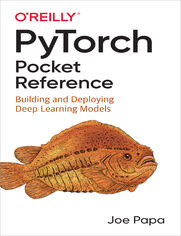PyTorch Pocket Reference - Helion

ISBN: 9781492089957
stron: 310, Format: ebook
Data wydania: 2021-05-11
Ksi─Ögarnia: Helion
Cena ksi─ů┼╝ki: 72,24 z┼é (poprzednio: 84,99 z┼é)
Oszczędzasz: 15% (-12,75 zł)
This concise, easy-to-use reference puts one of the most popular frameworks for deep learning research and development at your fingertips. Author Joe Papa provides instant access to syntax, design patterns, and code examples to accelerate your development and reduce the time you spend searching for answers.
Research scientists, machine learning engineers, and software developers will find clear, structured PyTorch code that covers every step of neural network developmentâ??from loading data to customizing training loops to model optimization and GPU/TPU acceleration. Quickly learn how to deploy your code to production using AWS, Google Cloud, or Azure and deploy your ML models to mobile and edge devices.
- Learn basic PyTorch syntax and design patterns
- Create custom models and data transforms
- Train and deploy models using a GPU and TPU
- Train and test a deep learning classifier
- Accelerate training using optimization and distributed training
- Access useful PyTorch libraries and the PyTorch ecosystem
Osoby które kupowały "PyTorch Pocket Reference", wybierały także:
- Jak zhakowa 125,00 zł, (10,00 zł -92%)
- Biologika Sukcesji Pokoleniowej. Sezon 3. Konflikty na terytorium 117,27 zł, (12,90 zł -89%)
- Power BI Desktop. Kurs video. Wykorzystanie narzędzia w analizie i wizualizacji danych 335,45 zł, (36,90 zł -89%)
- Windows Media Center. Domowe centrum rozrywki 66,67 zł, (8,00 zł -88%)
- Podręcznik startupu. Budowa wielkiej firmy krok po kroku 92,14 zł, (12,90 zł -86%)
Spis tre┼Ťci
PyTorch Pocket Reference eBook -- spis tre┼Ťci
- Preface
- Who Should Read This Book
- Why I Wrote This Book
- Navigating This Book
- Conventions Used in This Book
- Using Code Examples
- OReilly Online Learning
- How to Contact Us
- Acknowledgments
- 1. An Introduction to PyTorch
- What Is PyTorch?
- Why Use PyTorch?
- Getting Started
- Running in Google Colaboratory
- Running on a Local Computer
- Running on Cloud Platforms
- Running on AWS
- Running on Microsoft Azure
- Running on Google Cloud Platform
- Verifying Your PyTorch Environment
- A Fun Example
- 2. Tensors
- What Is a Tensor?
- Simple CPU Example
- Simple GPU Example
- Moving Tensors Between CPUs and GPUs
- Creating Tensors
- Tensor Attributes
- Data Types
- Creating Tensors from Random Samples
- Creating Tensors Like Other Tensors
- Tensor Operations
- Indexing, Slicing, Combining, and Splitting Tensors
- Tensor Operations for Mathematics
- Automatic Differentiation (Autograd)
- What Is a Tensor?
- 3. Deep Learning Development with PyTorch
- The Overall Process
- Data Preparation
- Data Loading
- Data Transforms
- Data Batching
- General Data Preparation (torch.utils.data)
- Dataset classes
- Sampler classes
- DataLoader classes
- Model Development
- Model Design
- Using existing and pretrained models
- The PyTorch NN module (torch.nn)
- Training
- Fundamental training loop
- Loss functions
- Optimizer algorithms
- Validation
- Testing
- Model Design
- Model Deployment
- Saving Models
- Deploying to PyTorch Hub
- Deploying to Production
- 4. Neural Network Development Reference Designs
- Image Classification with Transfer Learning
- Data Processing
- Model Design
- Training and Validation
- Testing and Deployment
- Sentiment Analysis with Torchtext
- Data Processing
- Model Design
- Training and Validation
- Testing and Deployment
- Generative LearningGenerating Fashion-MNIST Images with DCGAN
- Data Processing
- Model Design
- Training
- Testing and Deployment
- Image Classification with Transfer Learning
- 5. Customizing PyTorch
- Custom Layers and Activations
- Custom Layer Example (Complex Linear)
- Custom Activation Example (Complex ReLU)
- Custom Model Architectures
- Custom Loss Functions
- Custom Optimizer Algorithms
- Custom Training, Validation, and Test Loops
- Custom Layers and Activations
- 6. PyTorch Acceleration and Optimization
- PyTorch on a TPU
- PyTorch on Multiple GPUs (Single Machine)
- Data Parallel Processing
- The multithreaded approach using nn.DataParallel
- The multiprocess approach using DDP (preferred)
- Model Parallel Processing
- Combined Data Parallel Processing and Model Parallel Processing
- Data Parallel Processing
- Distributed Training (Multiple Machines)
- Model Optimization
- Hyperparameter Tuning
- Quantization
- Pruning
- Pruning model example
- Local and global pruning
- Pruning API
- Custom pruning methods
- 7. Deploying PyTorch to Production
- PyTorch Deployment Tools and Libraries
- Common Example Model
- Python API
- TorchScript
- TorchServe
- Install TorchServe and torch-model-archiver
- Package a model archive
- Run TorchServe
- Request predictions
- Logging and monitoring
- ONNX
- Mobile Libraries
- Deploying to a Flask App
- Colab Flask App
- Deploying to the Cloud with TorchServe
- Quick Start with Docker
- Deploying to Mobile and Edge
- iOS
- Android
- Other Edge Devices
- PyTorch Deployment Tools and Libraries
- 8. The PyTorch Ecosystem and Additional Resources
- The PyTorch Ecosystem
- Torchvision for Image and Video
- Datasets and I/O
- Models
- Transforms, Operations, and Utilities
- Torchtext for NLP
- Create a Dataset Object
- Preprocess Data
- Create a Dataloader for Batching
- Data (torchtext.data)
- Datasets (torchtext.datasets)
- Vocabularies (torchtext.vocab)
- TensorBoard for Visualization
- Learning Curves with SCALARS
- Model Architectures with GRAPHS
- Data with IMAGES, TEXT, and PROJECTOR
- Weight Distributions with DISTRIBUTIONS and HISTOGRAMS
- Hyperparameters with HPARAMS
- The TensorBoard API
- Papers with Code
- Additional PyTorch Resources
- Tutorials
- Books
- Online Courses and Live Training
- Index





